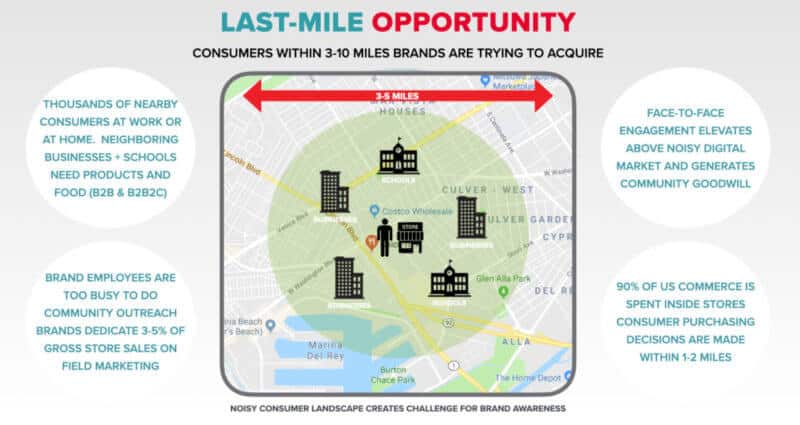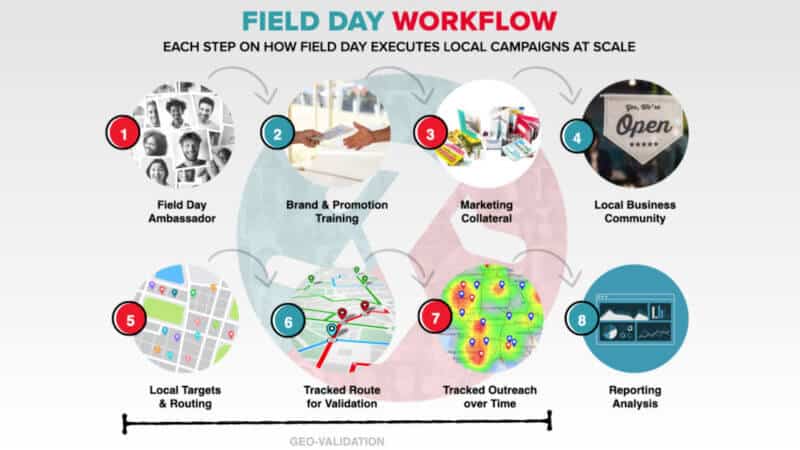Traditional media spending, including local TV, print, radio, out-of-home and direct mail, will be down between 15% and nearly 50% this year, depending on the medium. Some advertisers will never return, having shifted spending entirely to digital channels.
The decline of traditional, local media spending, however, doesn’t eliminate the need for a local marketing presence. Indeed, in some ways, the need for the trust and credibility that local media and marketing confer may be even greater now than in the recent past. Enter Field Day, which offers “last mile activation” and local field marketing to brands at scale.
Roster of B2B and B2C brands
Headquartered in Venice, California the company was founded in 2017. It has more than 50 national brand customers, including both B2B and B2C brands such as T-Mobile, Panera, Staples, Square, AT&T, Boston Market, Jamba Juice and Lyft, among others.
Field Day helps national-local brands realize ‘last mile opportunity’

Field Day has used the so-called “gig economy” model to build an extensive roster of local contractors that can offer a range of services on a one-time, periodic or ongoing basis to enterprises. This includes inside and outside sales, as well as the ability to physically interact with customers in and around business locations (e.g., deliver samples) or local events.
What Field Day offers is almost unique in my observation: local reach with human engagement, built into a digital platform that makes nationwide scale immediately accessible.
The shift to telephone sales
Field Day CEO Alex Nocifera says that the company has screened more than 10,000 applicants and interviewed and trained more than 2,000 local “brand ambassadors” in 500 local markets since its inception. Unlike many other gig economy companies that offer relatively low pay, Field Day is paying $25 an hour.
According to Nocifera, Field Day is an “end to end solution for local sales and marketing activations” for multi-location brands. While one might expect the demand for local field marketing to have radically diminished during COVID, Nocifera told me that he’s seen increased demand because many of his customers “weren’t seeing conversions on digital; the time to market on TV and radio takes too long and ‘good OOH inventory’ wasn’t available.”
As mentioned, Field Day’s local brand ambassadors historically went into the community or visited businesses. COVID has, for the time being, shifted focus to the telephone, where the company competes with more traditional telemarketing vendors. The difference, Nocifera says, is the local knowledge and presence his ambassadors bring, compared with people in an actual or distributed call center, often offshore.
Field Day local field marketing process

Nocifera said that 90% of calls being made by Field Day ambassadors are being answered, which is almost unbelievable, given how people increasingly ignore calls if they don’t recognize phone numbers. But he says it’s because Field Day ambassadors are calling work phone numbers, which are typically being forwarded to mobile phones. And because of the “local connection, empathy and trust” that local ambassadors offer, 45% of calls are capturing desired information, such as email addresses, or otherwise achieving the targeted objective. (In this context, Field Day offers an interesting first-party data collection tool.)
Brand and performance marketing at the local level
Brands typically buy packages of hours by store, restaurant or business location depending on their objectives. This can be in a concentrated period or over the course of an extended period of time. Right now, packages typically involve phone outreach and follow-up. However, in the past and presumably after COVID is over, Field Day will return to a broader mix of services. For example, fast-casual restaurants have used Field Day to distribute samples or offers/coupons to businesses within a radius of new store locations.
Nocifera says Field Day has been used by national-local brands for both awareness and performance marketing. And unlike some local media channels, the company also offers digital reporting and analytics.
One potential issue is whether brands have any hesitation relying on contractors to represent them. However, Nocifera said that there’s extensive training that occurs through the Field Day platform and that reps are closely monitored for performance. “We’re watching performance daily and coaching them or, sometimes coaching them out; we record every call.” (This call data offers another interesting opportunity for brands.) He added that the pandemic has also created an available talent pool of high-quality applicants.
Lots of industry discussion suggests the future of marketing is entirely digital. But companies that invest exclusively in digital campaigns may find those channels are sometimes expensive and often less efficient than expected. That’s what drove many direct-to-consumer brands offline and into traditional media before the pandemic.
The future of marketing for brands with physical locations or those that sell through stores is a mix of online and offline — a hybrid model that recognizes the parallel integration of the digital and physical in consumers’ daily lives.
The post As local media lose budgets, Field Day offers ‘last mile activation’ for brands appeared first on Search Engine Land.
Source: IAB
